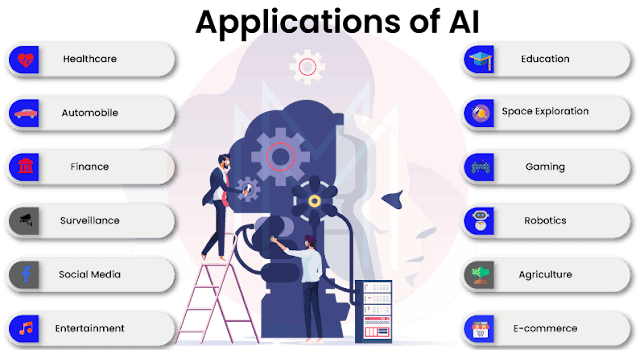When Intelligence and Protection Unite: "AI in Cybersecurity."
In today's increasingly digital world, the role of cybersecurity has never been more critical. With the Expansion of data breaches, ransomware attacks, and other cyber threats, businesses and individuals alike are constantly searching for more advanced and effective ways to protect their sensitive information. Enter AI-powered cybersecurity, where the marriage of intelligence and protection promises a new era of digital defense. In this essay, we will explore the role of AI in cybersecurity, its evolution, applications, benefits, challenges, and the profound impact it has on our increasingly interconnected world.
 |
Artificial Intelligence in Cyber Security |
"The Evolution of Cyber Threats"
Cybercriminals have developed more sophisticated strategies throughout time. The era of straightforward phishing emails with obvious warning indicators is over. Hackers of today frequently take advantage of flaws in technology and human nature by employing sophisticated strategies.
1. Phishing: Phishing attacks have evolved from poorly written emails to highly convincing messages that impersonate trusted entities. Attackers employ social engineering techniques to manipulate recipients into providing sensitive information or clicking malicious links.
2. Ransomware: Attackers now use encryption to prevent victims from accessing their data or computers until a ransom is paid, making ransomware a very serious danger. These assaults have the potential to destroy enterprises and cause huge financial losses.
3. Zero-day Exploits: Cybercriminals frequently take advantage of flaws in hardware or software that manufacturers or developers are unaware of in order to launch attacks.
As cyber threats have grown in complexity, traditional cybersecurity measures have struggled to keep pace. Conventional approaches, like signature-based antivirus software and static rule-based firewalls, rely on known patterns or signatures of attacks. They often fail to detect novel threats or adapt to rapidly changing attack tactics.
"The Revolution of AI Powered Cybersecurity"
Artificial Intelligence (AI) is revolutionizing the field of cybersecurity by offering a dynamic and intelligent defense against emerging threats. AI-powered cybersecurity systems use machine learning algorithms to analyze vast amounts of data and detect patterns and anomalies that might evade traditional defenses. It emerged as a response to the limitations of traditional methods. It leverages the capabilities of machine learning, deep learning, and natural language processing to analyze vast datasets, identify patterns, and recognize anomalies. This proactive approach, often called threat detection and response, enables organizations to identify and mitigate threats in real-time.
"The Key Elements of AI-Powered Cybersecurity"
Below are some of the key elements of AI-Powered Cybersecurity:
1. Machine Learning Algorithms: Machine learning models are trained on massive datasets to recognize patterns of normal behavior and identify deviations that could signify an attack. These models can continually adapt and improve their accuracy over time.
2. Behavorial Analysis: AI systems monitor the behavior of users and devices within a network. They can spot anomalies such as unusual access patterns or data transfers, which may indicate a breach.
3. Natural Language Processing (NLP): AI can analyze text-based data, such as emails and chat logs, to detect phishing attempts and identify malicious content.
4. Predictive Analysis: AI can predict potential threats by analyzing historical data and identifying trends that could indicate an impending attack.
5. Autonomous Response: In some cases, AI systems can take autonomous actions to contain or mitigate threats, reducing the response time and potential damage.
"The Benefits of AI-Powered Cybersecurity"
1. Enhanced Threat Detection: AI can identify threats that traditional systems might miss, especially zero-day exploits and advanced persistent threats.
2. Reduced False Positives: By learning what constitutes normal behavior within an organization, AI systems can significantly reduce the number of false alerts.
3. Real-Time Response: AI can respond to threats in real-time, taking action to mitigate the damage and prevent further infiltration.
4. Scalablity: AI can scale effortlessly to handle large volumes of data and traffic, making it suitable for organizations of all sizes.
5. Adaptability: AI systems continuously learn and adapt to new threats, staying ahead of the evolving threat landscape.
"Real World Applications"
AI-powered cybersecurity is making a tangible impact across various industries. Here are some real-world applications:
1. Financial Services: Banks and financial institutions use AI to detect fraudulent transactions, unauthorized access, and money laundering.
2. Healthcare: The healthcare industry relies on AI to protect patient data and ensure the integrity of medical records.
3. E-Commerce: Online retailers employ AI to combat payment fraud, safeguard customer data, and prevent account takeovers.
4. Critical Infrastructure: Power plants, water treatment facilities, and transportation networks use AI to defend against cyber threats that could disrupt essential services.
5. Cloud Security: Cloud service providers utilize AI to monitor and secure vast networks of servers and data centers.
"Challenges and Considerations"
While AI-powered cybersecurity offers significant advantages, it also presents challenges and considerations:
1. Data Privacy: AI systems require access to large datasets for training, raising concerns about data privacy and compliance with regulations such as GDPR and CCPA.
2. Sophisticated Adversaries: As AI defenses become more robust, cybercriminals may employ AI to craft more sophisticated attacks, leading to an AI arms race.
3. Bias and Fairness: AI algorithms can inherit biases from the data they are trained on, potentially resulting in unfair or discriminatory outcomes.
4. Resource Requirements: Implementing AI-powered cybersecurity solutions demands significant computational resources and expertise.
5. Human Expertise: AI is a tool, not a silver bullet. It should complement, not replace, human expertise in cybersecurity.






